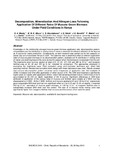Decomposition, Mineralization And Nitrogen Loss Following Application Of Different Rates Of Mucuna Green Biomass Under Field Conditions In Kenya

View/
Date
2010Author
Maobe, S.N.
Mburu, M.W.K.
Akundabweni, L.S.
Ndufa, J.K.
Mureithi, J.G.
Makini, F.
Okello, J.J.
Type
PresentationLanguage
enMetadata
Show full item recordAbstract
Knowledge on the relationship amongst mucuna green biomass application rate, decomposition pattern,
mineralization and its distribution in rooting zone of maize is essential for efficient utilization of the legume
as N source for maize production. Consequently, on-farm research was carried out for two seasons on
sandy clay soil of southwest Kenya in 2004. The objective was to determine effect of different application
rates of mucuna green biomass on its decomposition pattern, available soil N, distribution in rooting zone
of maize, and leaching beyond the zone during the season when the biomass is incorporated into the soil.
The treatments were mucuna applied at rates of 0, 30, 60, 120, 240 and 480 kg N ha-1; and inorganic
fertilizer-urea at 30, 60 and 120 kg N ha-1 included for comparison. The approaches employed in
evaluating the treatments were: Field incubation using micro-lysimeter technique and, direct field
sampling method. Randomized complete block design with three replications was used. Results showed
that mucuna decomposition pattern remained same irrespective of application rate. Soil available N
(SAN) increased over time after application of either source of N. The SAN level reached a significantly
higher peak at 2 weeks after application (WAA). Direct field sampling showed that at 2 WAA most of the N
accumulated at 50–100 cm depth, regardless of the N source. Significant differences in SAN level
attributed to application of the various rates of mucuna and fertilizer were notable at 2 WAA, but had
disappeared by 4 WAA. At the 2 WAA, fertilizer and mucuna applied at 60 and 120 kg N ha-1 respectively
gave comparable SAN level and had non-significant effect on it at 0-15 and 15–30 cm depths. It required
240 kg N ha-1 equivalent of mucuna green biomass, or 120 kg N ha-1 of inorganic fertilizer-urea to
substantially increase SAN level over the control. The loss of N beyond maize rooting zone was
significantly higher from inorganic fertilizer than mucuna and the control, which were the same.
Citation
BALWOIS 2010 – Ohrid, Republic of Macedonia – 25, 29 May 2010Description
Research Paper
Collections
- Faculty of Agriculture [226]
